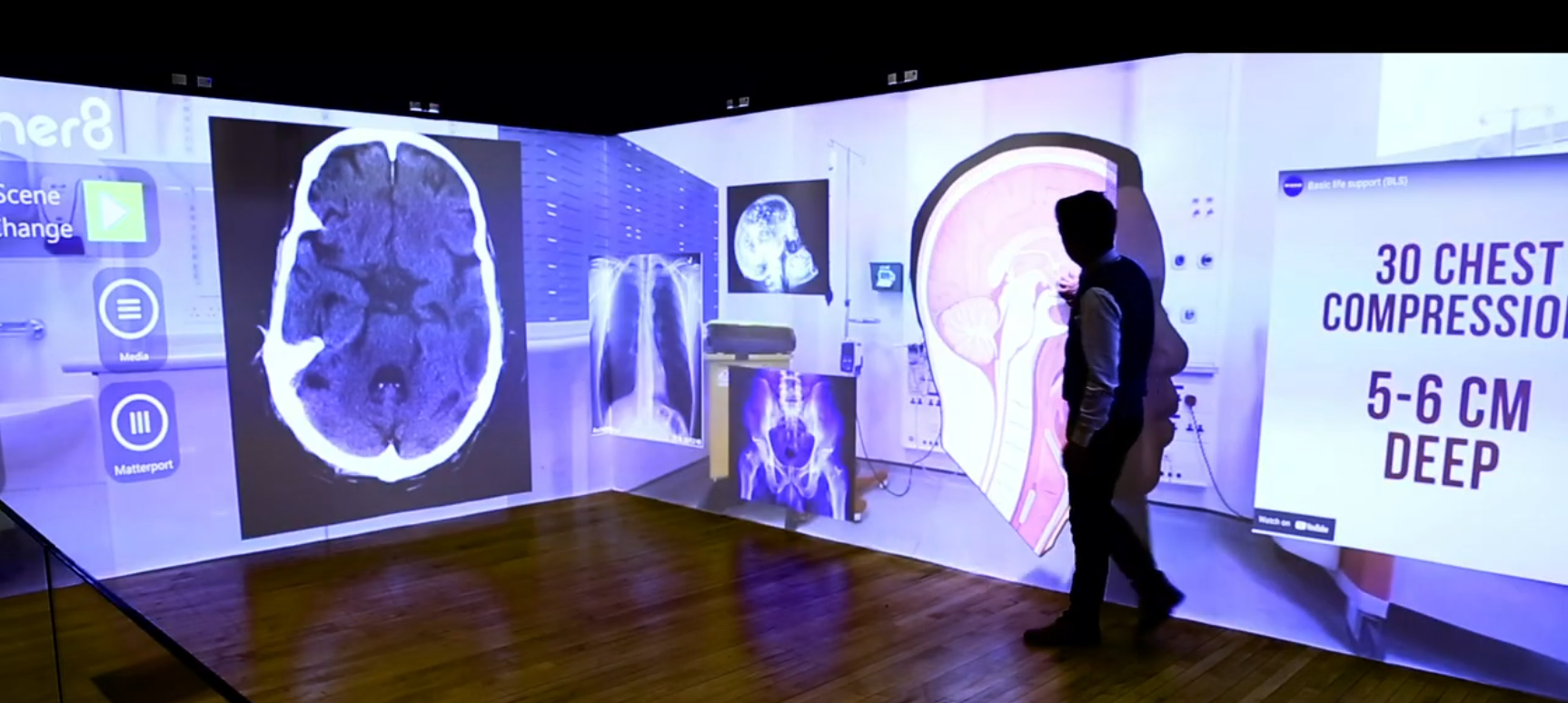Medical education is evolving rapidly thanks to immersive and interactive technologies. Gener8 immersive room, exclusively distributed in Italy by Simulkare, represents a fundamental innovation for the training of Medicine and Surgery students at the University of Turin and AOU San Luigi Gonzaga staff. This advanced technology makes it possible to recreate complex clinical environments and realistic emergency scenarios, providing a unique training experience. Through direct interaction with virtual environments, participants can improve their practical and decision-making skills, leading to more effective learning and optimal preparation for real clinical practice.
Advertorial
Introduction
Medical education is undergoing a profound transformation, mainly due to the integration of innovative digital technologies and interactive teaching methodologies. Indeed, in recent years, both the availability and use of highly advanced patient simulators (in function and physiognomy), virtual reality (VR), augmented reality (AR) and artificial intelligence (AI) have grown exponentially, revolutionising teaching and practical training in medicine and the health professions. One of these innovations is Gener8 immersive room, a state-of-the-art platform that uses interactive simulation technologies to virtually recreate complex clinical environments, out-of-hospital emergency situations or environments that are difficult to access in everyday reality (e.g. simulation of an operation in high mountains, etc.). Currently, this technology is used at the MedSim Advanced Medical Simulation Centre of the University of Turin, which is part of the Department of Clinical and Biological Sciences and located within the AOU San Luigi Gonzaga, where it offers new opportunities for training students and healthcare professionals.
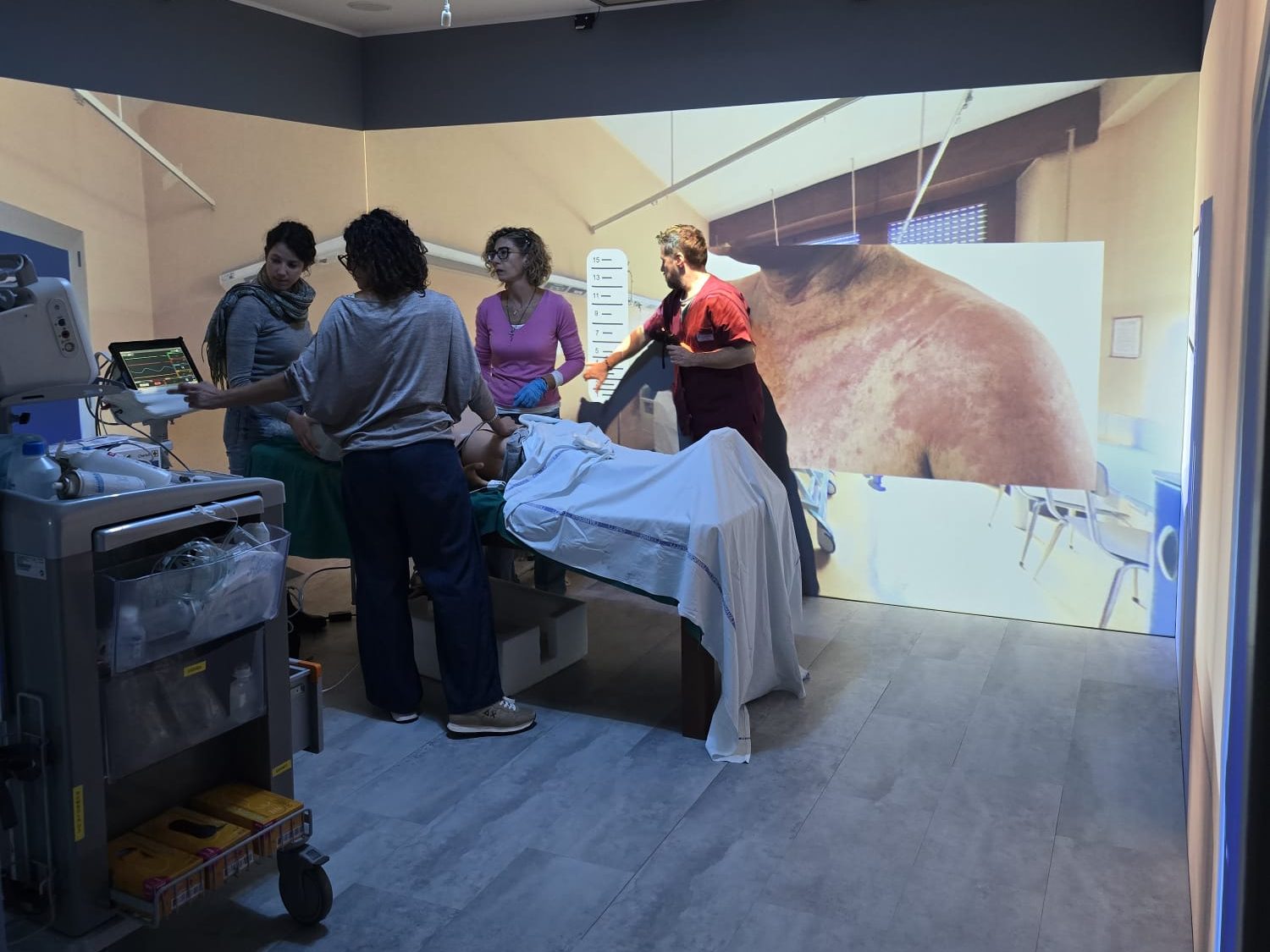
The Advanced Technology of Gener8 Immersive Room
Gener8 immersive room is based on a combination of advanced immersive and interactive technologies designed to deliver high-fidelity simulation experiences. Its purpose is to recreate realistic environments in which participants can interact with simulated contexts in a natural way, experiencing not only the clinical side of a scenario, but also the emotional and sensory aspects. This technology offers the possibility of three-dimensional mapping of real spaces such as operating theatres, hospital rooms, ambulances or emergency scenarios through the use of 360-degree cameras. These physical environments can be faithfully reproduced within the immersive room by means of dedicated software that reprocesses the images to generate the right compatibility with the three interactive walls. In addition, it allows the detailed recreation of the working spaces of healthcare professionals, enabling them to practice or learn new procedures or skills while having the feeling of being in their natural working environment. Furthermore, students can also learn and practise in simulated settings that faithfully reflect hospital or non-hospital conditions, thus increasing the realism of the training experience. This approach is particularly useful in complex or rare scenarios that may be difficult to simulate in everyday clinical practice.
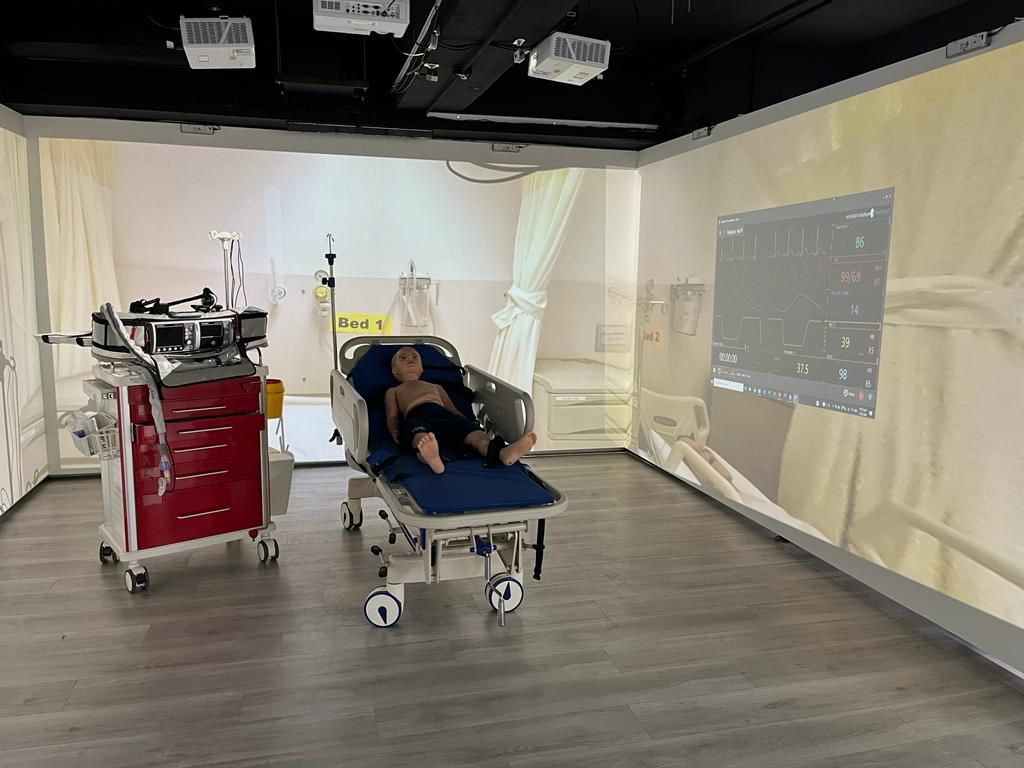
A feature of this immersive room lies in the level of interactivity it offers. Every element of the simulated environment can be manipulated in real time through the use of touch technologies and sensors. Participants can interact with virtual devices, such as electromedical monitors or simulated surgical instruments, and even with virtual patients. This type of interaction allows users to carry out clinical activities in a fully immersive manner, as if they were operating in a real context. In addition, the ability to resize, move and modify virtual objects and instruments provides direct and dynamic control over simulation elements, making learning even more hands-on and engaging. Furthermore, in this immersive room there is the possibility to simulate not only the physical environment, but also atmospheric and sensory conditions. This makes it possible to introduce elements such as wind, fog, or temperature variations, increasing the level of realism of simulated scenarios. It is also possible to use auditory and olfactory stimuli to reproduce specific environmental sounds or smells characteristic of particular situations, such as a fire, using specific equipment compatible with the room itself. Such sensory stimuli make it possible to recreate complex scenarios such as a car accident on a cold, foggy day or a mountain rescue in extreme weather conditions. These additional factors make the training experience complete, training participants not only to handle clinical conditions but also to remain calm and effective in decision-making in situations of psychological and physical stress.
All existing or newly constructed scenarios can be customised and modified in real time via the Intuiface composer software, allowing the creation of tailor-made environments based on the specific needs of the course or training, integrating images, videos, 3D models and real clinical tools. This feature allows the scenarios to be quickly modified in real time and the simulation to be adapted to the participants’ level of preparation and their specific learning needs, making each session a functional training experience.
Finally, everything that happens in the immersive room can be captured and video-recorded from the control room. Furthermore, when the number of course participants is very high, there is also the possibility of sharing, in real time, images of the scenarios taking place in a conference room or lecture hall, so that everyone can witness what is happening inside the immersive room.
Pedagogical Innovation in Medical Education
The introduction of Gener8 immersive room in the educational context of the medical degree course represents a quantum leap in the pedagogical approach. This technology offers an ideal synthesis between theoretical learning and practical application, giving students the opportunity to immerse themselves in realistic clinical scenarios that reproduce complex pathological situations.
A strength of the immersive room is the possibility to simulate rare clinical cases or scenarios that might not be easily accessible during conventional practical experiences. For example, a student may be exposed to a cardiological emergency in a patient in an out-of-hospital setting, or to the management of a person with an altered mental condition in an unconventional environment such as an abandoned house or a dimly lit subway. These experiences help to develop decision-making and operational skills in controlled and risk-free conditions for both patient and caregiver, providing a safe environment in which to apply and learn. Furthermore, in immersive rooms, it is possible to replicate high-risk scenarios in which rapid and accurate decision-making is crucial. Access to these types of simulations prepares students to handle critical situations in real clinical practice, improving not only their technical skills but also their interpersonal and collaborative skills. Indeed, the ability to repeat a scenario several times and receive immediate feedback fosters iterative learning, where mistakes become an integral part of the training process. In addition, the immersive room offers an ideal teaching space for collaborative and multidisciplinary learning through complex clinical scenarios involving students from different disciplines (medicine, nursing, etc.). In this context, they can interact and work together, developing not only their own skills but also a greater awareness of the roles and responsibilities of other healthcare professionals. This learning dynamic is essential to prepare students for the real challenges of clinical practice, where teamwork is essential to ensure quality care. Finally, the use of immersive technologies stimulates students’ interest and motivation, creating a dynamic and engaging learning environment. The high level of engagement not only enhances training effectiveness, but also helps prepare future healthcare professionals more competent in the use of emerging technologies that are transforming clinical practice.
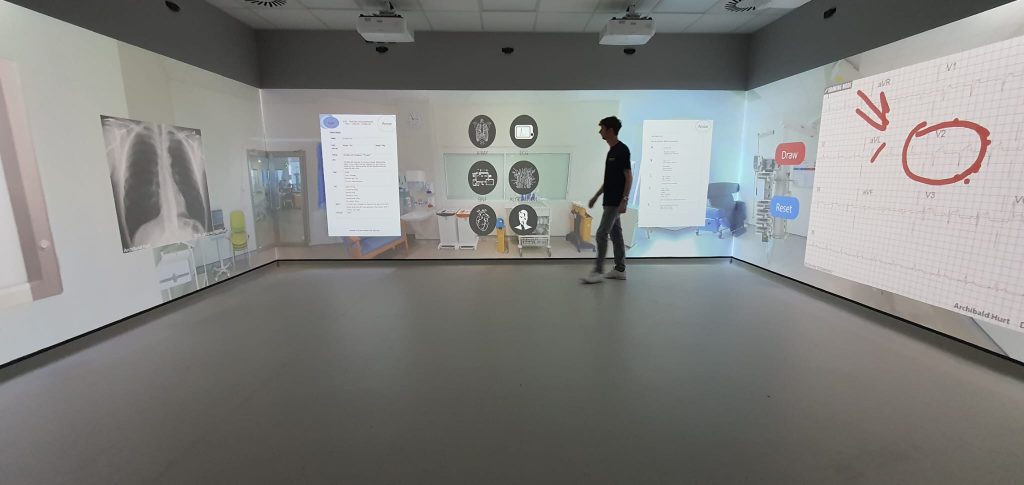
Using Gener8 immersive room at the MedSim Advanced Medical Simulation Centre
Gener8 immersive room is used at the University of Turin’s MedSim Advanced Medical Simulation Centre and is regularly used in the delivery of the centre’s teaching and research activities, which aim to improve the technical and decision-making skills of students and healthcare professionals.
One of the main applications of the room is the simulation of out-of-hospital emergencies for students in the 6th year of the international degree course in Medicine and Surgery (in English). Students are immersed in realistic scenarios that reproduce traffic accidents, psychiatric crises, and rescue situations in difficult environments. These exercises allow them to begin to become acquainted with the world of out-of-hospital medical care, an environment in which they can easily be employed as soon as they have qualified as doctors.
In parallel, the room is used for the training of hospital staff, particularly for doctors and nurses who wish to perfect their management and operational skills. The room makes it possible to reproduce mapped clinical environments, such as patient rooms, intensive care units and operating theatres, enabling professionals to practise complex clinical cases. This highly realistic simulation allows participants to deal with critical situations that can occur daily in hospital wards, improving team coordination and emergency management.
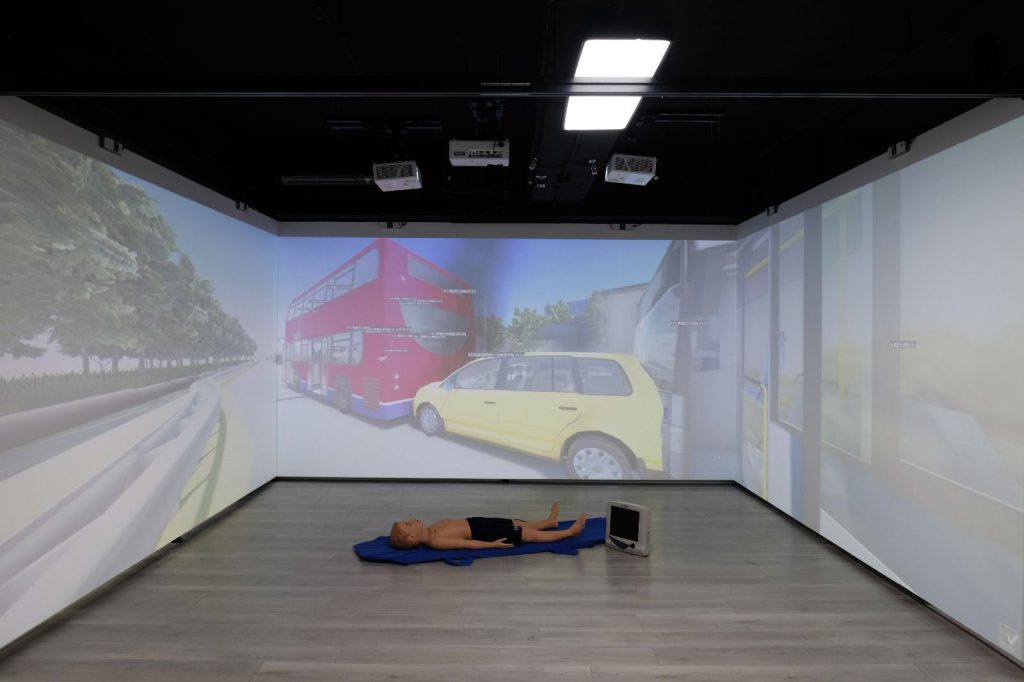
Finally, Gener8 immersive room also finds application in dissertation research projects. It has been used, for example, to reproduce a real environment but with controlled parameters such as constant temperature and humidity. One example of research carried out in the immersive room concerns the assessment of the perception of fatigue in multiple sclerosis patients during physical exercises at different environmental temperatures (hot/cold). Another study that was conducted in the immersive room consisted of comparing the effectiveness of high and low simulative fidelity in the recognition by medical students of the need to perform a haemogasanalysis (EGA) on a patient with a certain clinical picture. In this case, an in-patient room was reproduced in the immersive room, supplemented with sounds and smells typical of that place to bring the simulative fidelity to an extremely high level. A summary of the activities carried out in the immersive room at the MedSim simulation centre can be seen in the table below.
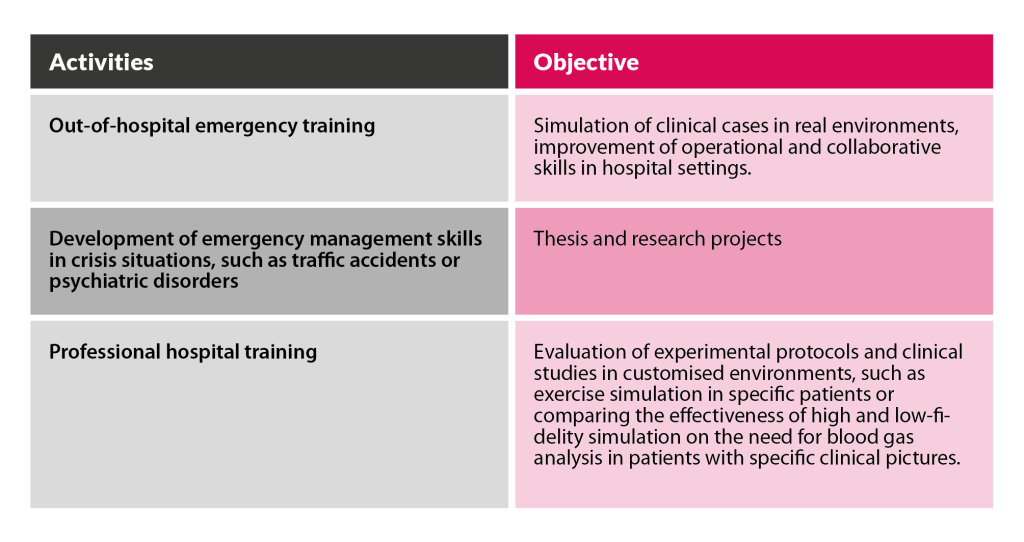
Future perspectives
The future perspectives of the MedSim Centre aim at enhancing students’ access to immersive learning experiences. In fact, the aim of the MedSim centre is to provide students with the opportunity to develop a connection between theoretical knowledge, practical application and emotional involvement from the earliest years of their university career, an element that characterises the exercise of the medical profession. In addition, the centre aims, in the long term, to keep up with technological development in order to make simulations even more interactive and customisable, adapting them to the different levels of preparation of the students. This approach will make it possible to train future healthcare professionals in an increasingly targeted and specific manner, so that they will be ready to face future work challenges with a higher level of awareness.

Federico Abate Daga – Dipartimento di Scienze Cliniche e Biologiche, Università degli Studi di Torino, Torino, Italia
Lorenzo Odetto – A.O.U. San Luigi Gonzaga, Regione Gonzole 10, 10043, Orbassano, Torino, Italia
Giuseppe Reimondo – Dipartimento di Scienze Cliniche e Biologiche, Università degli Studi di Torino, Torino, Italia, A.O.U. San Luigi Gonzaga, Regione Gonzole 10, 10043, Orbassano, Torino, Italia
Marinella Clerico – Dipartimento di Scienze Cliniche e Biologiche, Università degli Studi di Torino, Torino, Italia, A.O.U. San Luigi Gonzaga, Regione Gonzole 10, 10043, Orbassano, Torino, Italia
Savino Sciascia – Dipartimento di Scienze Cliniche e Biologiche, Università degli Studi di Torino, Torino, Italia
David Lembo – Dipartimento di Scienze Cliniche e Biologiche, Università degli Studi di Torino, Torino, Italia
READ ALSO



